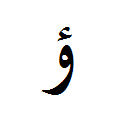Waw (Arabic letter)
| connected shape | |
|---|---|
| from the right: | ـو |
Wāw ( Arabic واو) is the 27th letter of the Arabic alphabet . It is from the Phoenician Vav emerged and thus with the Latin F , V (and thus also U and W ) and Y used. Its counterpart in the Greek alphabet is no longer used Digamma and in the Hebrew alphabet, the Waw . The numerical value 6 is assigned to it.
Sound value and transcription
The waw is one of the two semiconsonants in Arabic. Depending on the word, it stands for a consonant or serves to lengthen the vowel.
- As a consonant, the waw corresponds to the voiced labiovelar approximant , thus the English "w" sound in white or water . It is reproduced in the DMG inscription with a “w”;
- As a sign for the vowel elongation, Waw stands for the closed (= "long") U as in "Usedom", as an elongation of the short u ( damma ). It is then reproduced in the DMG inscription as “u” with a line above it (ū).
Furthermore, Waw can serve as a carrier vowel for the Hamza .
In the first name عمرو Amr the bastard is dumb. In the wordصلوة salah (prayer ritual), that tooصلاةcan be written, and a few more words it is spoken like Alif .
Waw in Unicode
| Unicode codepoint | U + 0648 |
|---|---|
| Unicode name | ARABIC LETTER WAW |
| HTML | & # 1608; |
| ISO 8859-6 | 0xe8 |

